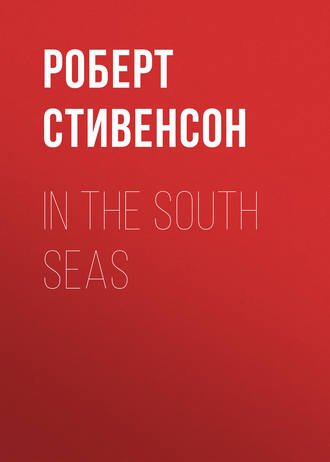
Роберт Льюис Стивенсон
In the South Seas
It is plain we have in Europe stories of a similar complexion; and the Polynesian varua ino or aitu o le vao is clearly the near kinsman of the Transylvanian vampire. Here is a tale in which the kinship appears broadly marked. On the atoll of Penrhyn, then still partly savage, a certain chief was long the salutary terror of the natives. He died, he was buried; and his late neighbours had scarce tasted the delights of licence ere his ghost appeared about the village. Fear seized upon all; a council was held of the chief men and sorcerers; and with the approval of the Rarotongan missionary, who was as frightened as the rest, and in the presence of several whites – my friend Mr. Ben Hird being one – the grave was opened, deepened until water came, and the body re-interred face down. The still recent staking of suicides in England and the decapitation of vampires in the east of Europe form close parallels.
So in Samoa only the spirits of the unburied awake fear. During the late war many fell in the bush; their bodies, sometimes headless, were brought back by native pastors and interred; but this (I know not why) was insufficient, and the spirit still lingered on the theatre of death. When peace returned a singular scene was enacted in many places, and chiefly round the high gorges of Lotoanuu, where the struggle was long centred and the loss had been severe. Kinswomen of the dead came carrying a mat or sheet and guided by survivors of the fight. The place of death was earnestly sought out; the sheet was spread upon the ground; and the women, moved with pious anxiety, sat about and watched it. If any living thing alighted it was twice brushed away; upon the third coming it was known to be the spirit of the dead, was folded in, carried home and buried beside the body; and the aitu rested. The rite was practised beyond doubt in simple piety; the repose of the soul was its object: its motive, reverent affection. The present king disowns indeed all knowledge of a dangerous aitu; he declares the souls of the unburied were only wanderers in limbo, lacking an entrance to the proper country of the dead, unhappy, nowise hurtful. And this severely classic opinion doubtless represents the views of the enlightened. But the flight of my Lafaele marks the grosser terrors of the ignorant.
This belief in the exorcising efficacy of funeral rites perhaps explains a fact, otherwise amazing, that no Polynesian seems at all to share our European horror of human bones and mummies. Of the first they made their cherished ornaments; they preserved them in houses or in mortuary caves; and the watchers of royal sepulchres dwelt with their children among the bones of generations. The mummy, even in the making, was as little feared. In the Marquesas, on the extreme coast, it was made by the household with continual unction and exposure to the sun; in the Carolines, upon the farthest west, it is still cured in the smoke of the family hearth. Head-hunting, besides, still lives around my doorstep in Samoa. And not ten years ago, in the Gilberts, the widow must disinter, cleanse, polish, and thenceforth carry about her, by day and night, the head of her dead husband. In all these cases we may suppose the process, whether of cleansing or drying, to have fully exorcised the aitu.
But the Paumotuan belief is more obscure. Here the man is duly buried, and he has to be watched. He is duly watched, and the spirit goes abroad in spite of watches. Indeed, it is not the purpose of the vigils to prevent these wanderings; only to mollify by polite attention the inveterate malignity of the dead. Neglect (it is supposed) may irritate and thus invite his visits, and the aged and weakly sometimes balance risks and stay at home. Observe, it is the dead man’s kindred and next friends who thus deprecate his fury with nocturnal watchings. Even the placatory vigil is held perilous, except in company, and a boy was pointed out to me in Rotoava, because he had watched alone by his own father. Not the ties of the dead, nor yet their proved character, affect the issue. A late Resident, who died in Fakarava of sunstroke, was beloved in life and is still remembered with affection; none the less his spirit went about the island clothed with terrors, and the neighbourhood of Government House was still avoided after dark. We may sum up the cheerful doctrine thus: All men become vampires, and the vampire spares none. And here we come face to face with a tempting inconsistency. For the whistling spirits are notoriously clannish; I understood them to wait upon and to enlighten kinsfolk only, and that the medium was always of the race of the communicating spirit. Here, then, we have the bonds of the family, on the one hand, severed at the hour of death; on the other, helpfully persisting.
The child’s soul in the Tahitian tale was wrapped in leaves. It is the spirits of the newly dead that are the dainty. When they are slain, the house is stained with blood. Rua’s dead fisherman was decomposed; so – and horribly – was his arboreal demon. The spirit, then, is a thing material; and it is by the material ensigns of corruption that he is distinguished from the living man. This opinion is widespread, adds a gross terror to the more ugly Polynesian tales, and sometimes defaces the more engaging with a painful and incongruous touch. I will give two examples sufficiently wide apart, one from Tahiti, one from Samoa.
And first from Tahiti. A man went to visit the husband of his sister, then some time dead. In her life the sister had been dainty in the island fashion, and went always adorned with a coronet of flowers. In the midst of the night the brother awoke and was aware of a heavenly fragrance going to and fro in the dark house. The lamp I must suppose to have burned out; no Tahitian would have lain down without one lighted. A while he lay wondering and delighted; then called upon the rest. ‘Do none of you smell flowers?’ he asked. ‘O,’ said his brother-in-law, ‘we are used to that here.’ The next morning these two men went walking, and the widower confessed that his dead wife came about the house continually, and that he had even seen her. She was shaped and dressed and crowned with flowers as in her lifetime; only she moved a few inches above the earth with a very easy progress, and flitted dryshod above the surface of the river. And now comes my point: It was always in a back view that she appeared; and these brothers-in-law, debating the affair, agreed that this was to conceal the inroads of corruption.
Now for the Samoan story. I owe it to the kindness of Dr. F. Otto Sierich, whose collection of folk-tales I expect with a high degree of interest. A man in Manu’a was married to two wives and had no issue. He went to Savaii, married there a third, and was more fortunate. When his wife was near her time he remembered he was in a strange island, like a poor man; and when his child was born he must be shamed for lack of gifts. It was in vain his wife dissuaded him. He returned to his father in Manu’a seeking help; and with what he could get he set off in the night to re-embark. Now his wives heard of his coming; they were incensed that he did not stay to visit them; and on the beach, by his canoe, intercepted and slew him. Now the third wife lay asleep in Savaii; – her babe was born and slept by her side; and she was awakened by the spirit of her husband. ‘Get up,’ he said, ‘my father is sick in Manu’a and we must go to visit him.’ ‘It is well,’ said she; ‘take you the child, while I carry its mats.’ ‘I cannot carry the child,’ said the spirit; ‘I am too cold from the sea.’ When they were got on board the canoe the wife smelt carrion. ‘How is this?’ she said. ‘What have you in the canoe that I should smell carrion?’ ‘It is nothing in the canoe,’ said the spirit. ‘It is the land-wind blowing down the mountains, where some beast lies dead.’ It appears it was still night when they reached Manu’a – the swiftest passage on record – and as they entered the reef the bale-fires burned in the village. Again she asked him to carry the child; but now he need no more dissemble. ‘I cannot carry your child,’ said he, ‘for I am dead, and the fires you see are burning for my funeral.’
The curious may learn in Dr. Sierich’s book the unexpected sequel of the tale. Here is enough for my purpose. Though the man was but new dead, the ghost was already putrefied, as though putrefaction were the mark and of the essence of a spirit. The vigil on the Paumotuan grave does not extend beyond two weeks, and they told me this period was thought to coincide with that of the resolution of the body. The ghost always marked with decay – the danger seemingly ending with the process of dissolution – here is tempting matter for the theorist. But it will not do. The lady of the flowers had been long dead, and her spirit was still supposed to bear the brand of perishability. The Resident had been more than a fortnight buried, and his vampire was still supposed to go the rounds.
Of the lost state of the dead, from the lurid Mangaian legend, in which infernal deities hocus and destroy the souls of all, to the various submarine and aerial limbos where the dead feast, float idle, or resume the occupations of their life on earth, it would be wearisome to tell. One story I give, for it is singular in itself, is well-known in Tahiti, and has this of interest, that it is post-Christian, dating indeed from but a few years back. A princess of the reigning house died; was transported to the neighbouring isle of Raiatea; fell there under the empire of a spirit who condemned her to climb coco-palms all day and bring him the nuts; was found after some time in this miserable servitude by a second spirit, one of her own house; and by him, upon her lamentations, reconveyed to Tahiti, where she found her body still waked, but already swollen with the approaches of corruption. It is a lively point in the tale that, on the sight of this dishonoured tabernacle, the princess prayed she might continue to be numbered with the dead. But it seems it was too late, her spirit was replaced by the least dignified of entrances, and her startled family beheld the body move. The seemingly purgatorial labours, the helpful kindred spirit, and the horror of the princess at the sight of her tainted body, are all points to be remarked.
The truth is, the tales are not necessarily consistent in themselves; and they are further darkened for the stranger by an ambiguity of language. Ghosts, vampires, spirits, and gods are all confounded. And yet I seem to perceive that (with exceptions) those whom we would count gods were less maleficent. Permanent spirits haunt and do murder in corners of Samoa; but those legitimate gods of Upolu and Savaii, whose wars and cricketings of late convulsed society, I did not gather to be dreaded, or not with a like fear. The spirit of Aana that ate souls is certainly a fearsome inmate; but the high gods, even of the archipelago, seem helpful. Mahinui – from whom our convict-catechist had been named – the spirit of the sea, like a Proteus endowed with endless avatars, came to the assistance of the shipwrecked and carried them ashore in the guise of a ray fish. The same divinity bore priests from isle to isle about the archipelago, and by his aid, within the century, persons have been seen to fly. The tutelar deity of each isle is likewise helpful, and by a particular form of wedge-shaped cloud on the horizon announces the coming of a ship.
To one who conceives of these atolls, so narrow, so barren, so beset with sea, here would seem a superfluity of ghostly denizens. And yet there are more. In the various brackish pools and ponds, beautiful women with long red hair are seen to rise and bathe; only (timid as mice) on the first sound of feet upon the coral they dive again for ever. They are known to be healthy and harmless living people, dwellers of an underworld; and the same fancy is current in Tahiti, where also they have the hair red. Tetea is the Tahitian name; the Paumotuan, Mokurea.
PART III: THE GILBERTS
CHAPTER I – BUTARITARI
At Honolulu we had said farewell to the Casco and to Captain Otis, and our next adventure was made in changed conditions. Passage was taken for myself, my wife, Mr. Osbourne, and my China boy, Ah Fu, on a pigmy trading schooner, the Equator, Captain Dennis Reid; and on a certain bright June day in 1889, adorned in the Hawaiian fashion with the garlands of departure, we drew out of port and bore with a fair wind for Micronesia.
The whole extent of the South Seas is a desert of ships; more especially that part where we were now to sail. No post runs in these islands; communication is by accident; where you may have designed to go is one thing, where you shall be able to arrive another. It was my hope, for instance, to have reached the Carolines, and returned to the light of day by way of Manila and the China ports; and it was in Samoa that we were destined to re-appear and be once more refreshed with the sight of mountains. Since the sunset faded from the peaks of Oahu six months had intervened, and we had seen no spot of earth so high as an ordinary cottage. Our path had been still on the flat sea, our dwellings upon unerected coral, our diet from the pickle-tub or out of tins; I had learned to welcome shark’s flesh for a variety; and a mountain, an onion, an Irish potato or a beef-steak, had been long lost to sense and dear to aspiration.
The two chief places of our stay, Butaritari and Apemama, lie near the line; the latter within thirty miles. Both enjoy a superb ocean climate, days of blinding sun and bracing wind, nights of a heavenly brightness. Both are somewhat wider than Fakarava, measuring perhaps (at the widest) a quarter of a mile from beach to beach. In both, a coarse kind of taro thrives; its culture is a chief business of the natives, and the consequent mounds and ditches make miniature scenery and amuse the eye. In all else they show the customary features of an atoll: the low horizon, the expanse of the lagoon, the sedge-like rim of palm-tops, the sameness and smallness of the land, the hugely superior size and interest of sea and sky. Life on such islands is in many points like life on shipboard. The atoll, like the ship, is soon taken for granted; and the islanders, like the ship’s crew, become soon the centre of attention. The isles are populous, independent, seats of kinglets, recently civilised, little visited. In the last decade many changes have crept in; women no longer go unclothed till marriage; the widow no longer sleeps at night and goes abroad by day with the skull of her dead husband; and, fire-arms being introduced, the spear and the shark-tooth sword are sold for curiosities. Ten years ago all these things and practices were to be seen in use; yet ten years more, and the old society will have entirely vanished. We came in a happy moment to see its institutions still erect and (in Apemama) scarce decayed.
Populous and independent – warrens of men, ruled over with some rustic pomp – such was the first and still the recurring impression of these tiny lands. As we stood across the lagoon for the town of Butaritari, a stretch of the low shore was seen to be crowded with the brown roofs of houses; those of the palace and king’s summer parlour (which are of corrugated iron) glittered near one end conspicuously bright; the royal colours flew hard by on a tall flagstaff; in front, on an artificial islet, the gaol played the part of a martello. Even upon this first and distant view, the place had scarce the air of what it truly was, a village; rather of that which it was also, a petty metropolis, a city rustic and yet royal.
The lagoon is shoal. The tide being out, we waded for some quarter of a mile in tepid shallows, and stepped ashore at last into a flagrant stagnancy of sun and heat. The lee side of a line island after noon is indeed a breathless place; on the ocean beach the trade will be still blowing, boisterous and cool; out in the lagoon it will be blowing also, speeding the canoes; but the screen of bush completely intercepts it from the shore, and sleep and silence and companies of mosquitoes brood upon the towns.
We may thus be said to have taken Butaritari by surprise. A few inhabitants were still abroad in the north end, at which we landed. As we advanced, we were soon done with encounter, and seemed to explore a city of the dead. Only, between the posts of open houses, we could see the townsfolk stretched in the siesta, sometimes a family together veiled in a mosquito-net, sometimes a single sleeper on a platform like a corpse on a bier.
The houses were of all dimensions, from those of toys to those of churches. Some might hold a battalion, some were so minute they could scarce receive a pair of lovers; only in the playroom, when the toys are mingled, do we meet such incongruities of scale. Many were open sheds; some took the form of roofed stages; others were walled and the walls pierced with little windows. A few were perched on piles in the lagoon; the rest stood at random on a green, through which the roadway made a ribbon of sand, or along the embankments of a sheet of water like a shallow dock. One and all were the creatures of a single tree; palm-tree wood and palm-tree leaf their materials; no nail had been driven, no hammer sounded, in their building, and they were held together by lashings of palm-tree sinnet.
In the midst of the thoroughfare, the church stands like an island, a lofty and dim house with rows of windows; a rich tracery of framing sustains the roof; and through the door at either end the street shows in a vista. The proportions of the place, in such surroundings, and built of such materials, appeared august; and we threaded the nave with a sentiment befitting visitors in a cathedral. Benches run along either side. In the midst, on a crazy dais, two chairs stand ready for the king and queen when they shall choose to worship; over their heads a hoop, apparently from a hogshead, depends by a strip of red cotton; and the hoop (which hangs askew) is dressed with streamers of the same material, red and white.
This was our first advertisement of the royal dignity, and presently we stood before its seat and centre. The palace is built of imported wood upon a European plan; the roof of corrugated iron, the yard enclosed with walls, the gate surmounted by a sort of lych-house. It cannot be called spacious; a labourer in the States is sometimes more commodiously lodged; but when we had the chance to see it within, we found it was enriched (beyond all island expectation) with coloured advertisements and cuts from the illustrated papers. Even before the gate some of the treasures of the crown stand public: a bell of a good magnitude, two pieces of cannon, and a single shell. The bell cannot be rung nor the guns fired; they are curiosities, proofs of wealth, a part of the parade of the royalty, and stand to be admired like statues in a square. A straight gut of water like a canal runs almost to the palace door; the containing quay-walls excellently built of coral; over against the mouth, by what seems an effect of landscape art, the martello-like islet of the gaol breaks the lagoon. Vassal chiefs with tribute, neighbour monarchs come a-roving, might here sail in, view with surprise these extensive public works, and be awed by these mouths of silent cannon. It was impossible to see the place and not to fancy it designed for pageantry. But the elaborate theatre then stood empty; the royal house deserted, its doors and windows gaping; the whole quarter of the town immersed in silence. On the opposite bank of the canal, on a roofed stage, an ancient gentleman slept publicly, sole visible inhabitant; and beyond on the lagoon a canoe spread a striped lateen, the sole thing moving.
The canal is formed on the south by a pier or causeway with a parapet. At the far end the parapet stops, and the quay expands into an oblong peninsula in the lagoon, the breathing-place and summer parlour of the king. The midst is occupied by an open house or permanent marquee – called here a maniapa, or, as the word is now pronounced, a maniap’ – at the lowest estimation forty feet by sixty. The iron roof, lofty but exceedingly low-browed, so that a woman must stoop to enter, is supported externally on pillars of coral, within by a frame of wood. The floor is of broken coral, divided in aisles by the uprights of the frame; the house far enough from shore to catch the breeze, which enters freely and disperses the mosquitoes; and under the low eaves the sun is seen to glitter and the waves to dance on the lagoon.
It was now some while since we had met any but slumberers; and when we had wandered down the pier and stumbled at last into this bright shed, we were surprised to find it occupied by a society of wakeful people, some twenty souls in all, the court and guardsmen of Butaritari. The court ladies were busy making mats; the guardsmen yawned and sprawled. Half a dozen rifles lay on a rock and a cutlass was leaned against a pillar: the armoury of these drowsy musketeers. At the far end, a little closed house of wood displayed some tinsel curtains, and proved, upon examination, to be a privy on the European model. In front of this, upon some mats, lolled Tebureimoa, the king; behind him, on the panels of the house, two crossed rifles represented fasces. He wore pyjamas which sorrowfully misbecame his bulk; his nose was hooked and cruel, his body overcome with sodden corpulence, his eye timorous and dull: he seemed at once oppressed with drowsiness and held awake by apprehension: a pepper rajah muddled with opium, and listening for the march of a Dutch army, looks perhaps not otherwise. We were to grow better acquainted, and first and last I had the same impression; he seemed always drowsy, yet always to hearken and start; and, whether from remorse or fear, there is no doubt he seeks a refuge in the abuse of drugs.
The rajah displayed no sign of interest in our coming. But the queen, who sat beside him in a purple sacque, was more accessible; and there was present an interpreter so willing that his volubility became at last the cause of our departure. He had greeted us upon our entrance: – ‘That is the honourable King, and I am his interpreter,’ he had said, with more stateliness than truth. For he held no appointment in the court, seemed extremely ill-acquainted with the island language, and was present, like ourselves, upon a visit of civility. Mr. Williams was his name: an American darkey, runaway ship’s cook, and bar-keeper at The Land we Live in tavern, Butaritari. I never knew a man who had more words in his command or less truth to communicate; neither the gloom of the monarch, nor my own efforts to be distant, could in the least abash him; and when the scene closed, the darkey was left talking.
The town still slumbered, or had but just begun to turn and stretch itself; it was still plunged in heat and silence. So much the more vivid was the impression that we carried away of the house upon the islet, the Micronesian Saul wakeful amid his guards, and his unmelodious David, Mr. Williams, chattering through the drowsy hours.







